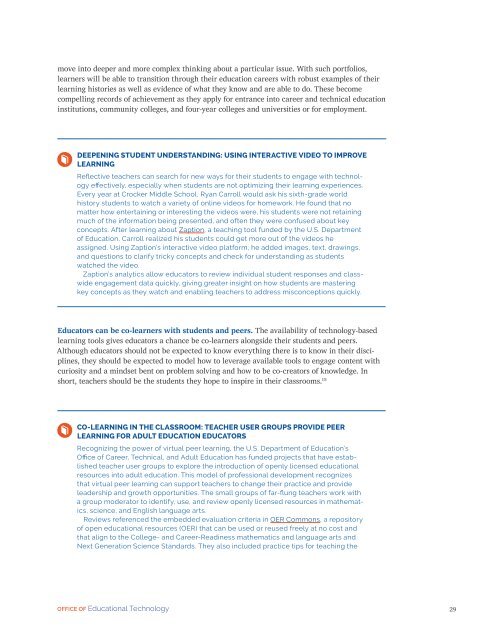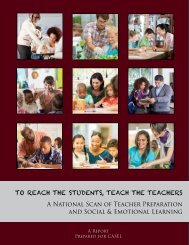Future Ready Learning
7m3sdJ
7m3sdJ
Create successful ePaper yourself
Turn your PDF publications into a flip-book with our unique Google optimized e-Paper software.
move into deeper and more complex thinking about a particular issue. With such portfolios,<br />
learners will be able to transition through their education careers with robust examples of their<br />
learning histories as well as evidence of what they know and are able to do. These become<br />
compelling records of achievement as they apply for entrance into career and technical education<br />
institutions, community colleges, and four-year colleges and universities or for employment.<br />
DEEPENING STUDENT UNDERSTANDING: USING INTERACTIVE VIDEO TO IMPROVE<br />
LEARNING<br />
Reflective teachers can search for new ways for their students to engage with technology<br />
effectively, especially when students are not optimizing their learning experiences.<br />
Every year at Crocker Middle School, Ryan Carroll would ask his sixth-grade world<br />
history students to watch a variety of online videos for homework. He found that no<br />
matter how entertaining or interesting the videos were, his students were not retaining<br />
much of the information being presented, and often they were confused about key<br />
concepts. After learning about Zaption, a teaching tool funded by the U.S. Department<br />
of Education, Carroll realized his students could get more out of the videos he<br />
assigned. Using Zaption’s interactive video platform, he added images, text, drawings,<br />
and questions to clarify tricky concepts and check for understanding as students<br />
watched the video.<br />
Zaption’s analytics allow educators to review individual student responses and classwide<br />
engagement data quickly, giving greater insight on how students are mastering<br />
key concepts as they watch and enabling teachers to address misconceptions quickly.<br />
Educators can be co-learners with students and peers. The availability of technology-based<br />
learning tools gives educators a chance be co-learners alongside their students and peers.<br />
Although educators should not be expected to know everything there is to know in their disciplines,<br />
they should be expected to model how to leverage available tools to engage content with<br />
curiosity and a mindset bent on problem solving and how to be co-creators of knowledge. In<br />
short, teachers should be the students they hope to inspire in their classrooms. 15<br />
CO-LEARNING IN THE CLASSROOM: TEACHER USER GROUPS PROVIDE PEER<br />
LEARNING FOR ADULT EDUCATION EDUCATORS<br />
Recognizing the power of virtual peer learning, the U.S. Department of Education’s<br />
Office of Career, Technical, and Adult Education has funded projects that have established<br />
teacher user groups to explore the introduction of openly licensed educational<br />
resources into adult education. This model of professional development recognizes<br />
that virtual peer learning can support teachers to change their practice and provide<br />
leadership and growth opportunities. The small groups of far-flung teachers work with<br />
a group moderator to identify, use, and review openly licensed resources in mathematics,<br />
science, and English language arts.<br />
Reviews referenced the embedded evaluation criteria in OER Commons, a repository<br />
of open educational resources (OER) that can be used or reused freely at no cost and<br />
that align to the College- and Career-Readiness mathematics and language arts and<br />
Next Generation Science Standards. They also included practice tips for teaching the<br />
OFFICE OF Educational Technology<br />
29



